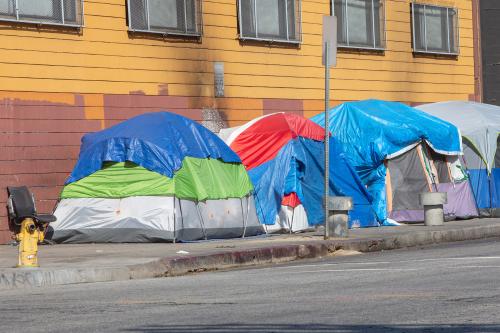As the economic consequences of the COVID-19 pandemic have grown increasingly dire for millions of Americans, the federal government, along with a growing number of state and local governments, have taken measures to protect homeowners and tenants from the threat of foreclosure and eviction.
In March 2020 the CARES Act imposed a federal moratorium on evictions, which mandated that it was illegal to evict tenants who participate in federal housing assistance programs or who live in properties with a federally backed mortgage loan due to the nonpayment of rent. When the CARES Act moratorium expired on July 24, a host of state and local governments passed their own eviction prevention measures—but these actions varied significantly across the country and left many renters vulnerable to eviction once again. Most recently on September 4, the Centers for Disease Control and Prevention (CDC) ordered an immediate, nationwide halt on evictions of any renter household due to the nonpayment of rent until December 31, 2020.
These moratorium policies were enacted in response to rising housing insecurity exacerbated by the COVID-19 recession. As of July 2020, one in three American renters had little to no confidence in their ability to pay next month’s rent (authors’ calculations); some estimates predicted as many as 40 million people faced potential eviction. Furthermore, the public health threat of displacement through eviction during the COVID-19 pandemic can put families at higher risk of contracting or spreading the coronavirus.
Nevertheless, an eviction moratorium is not a panacea for the problems created by housing insecurity. Because the moratoriums do not forgive or reduce rent payments, a moratorium policy merely delays the threat of eviction as renters continue to accumulate debt. But it is not only tenants who face great economic risk in the COVID-19 recession: without rental income, a significant number of noncorporate, “mom and pop” landlords—who may be coping with their own unemployment or additional expenses related to the COVID-19 pandemic—will also struggle to pay their mortgages, utilities bills, property taxes, maintenance costs, and other property-related expenses. Relative to larger, corporate landlords, “mom and pop” landlords likely have fewer resources to withstand long delays or significant reductions in rental income.
The loss of rental income under the eviction moratorium represents a significant income shock for smaller landlords of modest means. Our analysis finds that 40 percent of residential property units are owned by individual investor landlords. Among those owning residential investment property, roughly a third are from low- to moderate-income households; property income constitutes up to 20 percent of their total household income. Without rental assistance, tenants and smaller landlords alike will continue to struggle to make ends meet.
Who Are Landlords?
Using data from the 2018 Rental Housing Finance Survey (RHFS), figure 1 shows that just over 40 percent of residential units are owned by individual investors. Most other units (37 percent) are owned by limited liability partnerships (LLPs), limited partnerships (LPs), or limited liability companies (LLCs). Whereas LLP, LP, and LLC business structures can pool resources to reduce property-related expenses and spread the potential risks of property ownership across partners, individual investor landlords are fully liable for the assets and income invested in their property. This implies that unstable rent payments are even more detrimental for individual investors—often referred to as “mom and pop” landlords—who carry greater financial vulnerabilities.

“Mom and Pop” Landlords Rely on Rental Income
To better understand the economic circumstances of landlords, we leverage data from the 2016 Survey of Consumer Finances. We define landlord households in this data as households that own at least one residential investment property and receive income from that property. (Due to data limitations, we are unable to distinguish whether a household is the sole owner of this investment property or whether it is owned in partnership with another entity as in figure 1.)
Figure 2 shows the income distribution of landlord households and the share of these households’ total income derived from property income. Our analysis finds:
- Among landlord households, about 30 percent are low- to moderate-income (earning annual household incomes of less than $90,000).
- Property income comprises a greater proportion of low- to moderate-income landlord households’ total income than it does for higher income landlord households.
- Property income for landlord households earning less than $50,000 provides nearly 20 percent of their total household income.
- Property income only represents 5 percent of total household income for landlord households earning over $200,000.

Moreover, “mom and pop” landlords continue to bear the expenses of owning and maintaining residential units, even in the case when rental income declines. For the typical residential property owned by individual investors, which has 4 or fewer units, average annual operational expenses per unit range from $4,600 to $5,400. For many of these “mom and pop” landlords, property-related expenses can consume more than half of their property income. Without rental income to offset these expenses, low- to moderate-income landlords may struggle to maintain the residences on which tenants depend. Consistent rental income is essential for individual investor landlords—especially those of modest means who rely on rental income as a substantial portion of their total household budget.
For landlords renting to tenants whose rent is partially paid by government subsidies, those government payments mean that participating landlords receive some guaranteed income—even when the tenant is unable to afford rental payments themselves. In particular, the Housing Choice Voucher Program, also known as Section 8, is an affordable housing initiative that allows landlords to rent homes at lower market rates to qualified low-income tenants and pays the balance of a rent payment that exceeds 30 percent of a renter’s monthly income directly to the landlord on behalf of tenant. In this way, Section 8 provides a secure form of passive income.
However, our analysis of the Rental Housing Finance Survey shows that individual investors are less likely to house Section 8 tenants compared to multiunit properties owned by LLPs, LPs, or LLCs. In fact, the fraction of multiunit properties that are home to at least one tenant receiving Section 8 vouchers is more than 50 percent higher for multiunit properties owned by LLPs, LPs, or LLCs than for individual investor-owned multiunit properties (authors’ calculations).
Expanding the Section 8 voucher program would not only help ensure that more tenants who are eligible for housing assistance actually receive it, but also that more “mom and pop” landlords can secure guaranteed rental income via Section 8 government payments. In addition to strengthening Section 8 and other rental assistance policies, extending unemployment insurance benefits can help restore financial stability to tenants who may have missed rental payments due to job loss. In turn, this can also restore an essential rental income stream for smaller landlords.
While the nationwide eviction moratorium is only half of the solution, it serves as a critical protection for the health and economic security of renters. Landlords in several states are challenging the CDC’s moratorium and continuing to take tenants, who may not be aware of their rights under the new moratorium, to housing court. (Reports suggest that those eviction actions are largely led by corporate landlords.) To be sure, the eviction moratorium is critical for mitigating the spike in housing insecurity. However, larger, corporate landlords likely have relatively more financial resources to absorb a reduction or delay in rental income associated with the moratorium.
Without rental assistance, smaller landlords of low- to moderate-incomes may not be able to maintain their supply of rental housing and will experience a significant income shock due to the loss of rent payments under the moratorium. More specifically, emergency rental assistance resources should prioritize those facing the most severe housing insecurity, including those at high risk of homelessness. Supplementing the moratorium policy with federal rental assistance is critical to protect the long-term housing of tenants—and smaller landlords, too.






Commentary
An eviction moratorium without rental assistance hurts smaller landlords, too
September 21, 2020